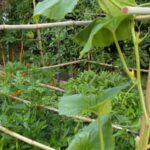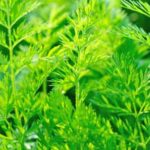Dyed mulch has gained popularity as a landscaping option for its vibrant colors and ability to enhance the overall appearance of gardens. However, when it comes to vegetable gardens, the safety of using dyed mulch becomes a topic of debate. Gardeners are concerned about the potential risks associated with the dyes used in mulch production and their effects on the vegetables they grow. In this article, we will delve into this controversy surrounding dyed mulch in vegetable gardens.
The use of dyed mulch has become a widely debated issue due to concerns about its impact on soil health and plant growth. While dyed mulch is visually appealing, many gardeners worry about the chemicals present in these dyes and whether they can leach into the surrounding soil or be absorbed by edible plants.
Understanding how dyed mulch is made and examining the different types of dyes used are crucial steps in determining whether it is safe for use in vegetable gardens.
This article aims to provide an unbiased assessment of the pros and cons of using dyed mulch in vegetable gardens. We will explore scientific research, expert opinions from environmentalists and horticulturists, as well as real-life experiences shared by gardeners who have utilized dyed mulch.
Additionally, we will discuss alternative organic and natural mulch options that can be considered for those seeking safer alternatives. By weighing all available information, gardeners will be better equipped to make informed decisions regarding the use of dyed mulch in their vegetable gardens.
The Basics – What is Dyed Mulch and How is it Made?
Dyed mulch has gained popularity as a decorative option for gardens, but what exactly is it and how is it made? Generally, dyed mulch is made from chipped wood or bark that is then colored using various dyes to achieve the desired appearance. The types of dyes used can vary, including both organic and synthetic options.
To create dyed mulch, the wood or bark material is first chipped into small pieces. These pieces are then mixed with water in a large vat or container. Next, the dye is added to the mixture, which can be either an organic dye derived from plant-based sources or a synthetic dye. The mixture is thoroughly mixed until all of the wood pieces are evenly coated with the dye.
After the coloring process, the dyed mulch needs to dry before it can be bagged and sold. This drying phase typically occurs in large piles where air circulation helps remove excess moisture from the mulch. Once dried, the mulch can be packaged and distributed for use in gardens.
It’s important to note that not all dyed mulches are created equal. Some manufacturers may use low-quality dyes that contain harmful chemicals, while others follow strict guidelines to ensure their products are safe for use in gardens. When considering using dyed mulch in your vegetable garden, it’s essential to research and choose a reputable brand that uses non-toxic dyes and environmentally-friendly production methods.
Examining the Different Types of Dyes Used in Mulch Production
Dyed mulch is a popular choice for adding color and aesthetic appeal to gardens. However, it is important for gardeners to understand the different types of dyes that are used in mulch production. This section will provide an overview of the different dyes commonly used, including synthetic dyes and natural plant-based dyes.
Synthetic Dyes
Synthetic dyes are the most common type of dyes used in dyed mulch production. These dyes are typically made from petroleum-based chemicals that are manufactured to achieve vibrant colors. The advantage of synthetic dyes is their ability to produce bold and long-lasting colors, which can enhance the visual appeal of your garden.
However, there is some concern about the potential health and environmental risks associated with these chemicals. Some studies have suggested that synthetic dyes may contain heavy metals or other toxic substances that could pose a risk to plants and soil when applied in large amounts.
Natural Plant-Based Dyes
In recent years, there has been a growing interest in using natural plant-based dyes for mulch production as an alternative to synthetic dyes. These dyes are derived from various sources such as fruits, vegetables, flowers, or tree barks. Natural plant-based dyes offer several advantages over synthetic dyes.
They are generally considered safe for plants and soil as they do not contain harmful chemicals or heavy metals. Additionally, natural plant-based dyes often fade gradually over time, which some gardeners find more visually appealing. However, it’s worth noting that natural plant-based dyes may not offer the same level of color intensity or longevity compared to synthetic options.
When choosing dyed mulch for your vegetable garden, it is important to read labels and research the specific type of dye used by the manufacturer. Look for products that clearly indicate whether they use synthetic or natural plant-based dyes. It is also advisable to choose mulch from reputable manufacturers that have a track record of producing safe and high-quality products.
Additionally, consider the overall health and condition of your garden. If you have sensitive plants or are growing food crops, it may be best to opt for natural plant-based dyes or explore alternative organic mulch options.
Overall, the type of dye used in mulch production can play a significant role in determining its safety for vegetable gardens. By understanding the different types of dyes available and their potential impact on plants and soil, gardeners can make more informed decisions when choosing dyed mulch for their gardens.
Potential Risks
Dyed mulch is a popular choice for landscaping and gardening due to its vibrant colors and ability to enhance the appearance of garden beds. However, there are concerns about the potential risks associated with using dyed mulch in vegetable gardens. This section will explore the chemicals found in dyed mulch and their effects on vegetable gardens.
One of the primary concerns with dyed mulch is the presence of chemicals such as heavy metals and toxic substances. Some studies have found that certain dyes used in mulch production contain high levels of heavy metals like arsenic, chromium, and lead. These chemicals can leach into the soil over time and may be absorbed by plants, potentially contaminating the vegetables grown in the garden.
The effects of these chemicals on vegetable gardens can vary depending on factors such as the type of dye used, concentration levels, and exposure duration. For example, high levels of arsenic can inhibit plant growth and development, leading to stunted or deformed vegetables. Chromium can affect soil microbiology and nutrient availability, negatively impacting plant health. Lead exposure can result in reduced yields and poor crop quality.
To minimize the potential risks associated with dyed mulch in vegetable gardens, it is important to consider alternative options or follow best practices when using dyed mulch. In the next sections of this article, we will discuss organic and natural mulch alternatives for vegetable gardens as well as provide guidelines on how to safely use dyed mulch if it is your preference.
- Some dyes used in mulch production may contain heavy metals like arsenic, chromium, and lead.
- These chemicals can leach into the soil over time.
- Effects on vegetable gardens include inhibited plant growth, reduced yields, poor crop quality.
- Alternative options or best practices are recommended to minimize risks.
Expert Opinions
Environmentalists’ Perspective
Many environmentalists express concern about the use of dyed mulch in vegetable gardens. They argue that the dyes used in the mulch production process can leach chemicals into the soil, potentially contaminating the vegetables that are grown in it. These chemicals can include heavy metals, such as arsenic and chromium, which are known to be harmful to human health.
Environmentalists emphasize the importance of considering the long-term effects of using dyed mulch in vegetable gardens. They believe that even if immediate negative effects are not evident, the accumulation of chemicals in the soil over time can have detrimental impacts on both human health and the environment.
It is important to note that some environmentalists advocate for organic gardening practices, which promote natural and chemical-free methods for growing vegetables. They argue that using dyed mulch contradicts these principles and may introduce unnecessary risks to both humans and ecosystems.
Horticulturists’ Outlook
The opinions of horticulturists regarding the use of dyed mulch in vegetable gardens are varied. Some argue that when used correctly and responsibly, there is minimal risk associated with using dyed mulch. They believe that any potential chemical leaching from the dyes is unlikely to reach levels high enough to cause harm to either plants or humans.
On the other hand, some horticulturists caution against using dyed mulch altogether. They suggest that even minimal risks should be avoided when it comes to growing food crops. These horticulturists recommend seeking alternative options for maintaining healthy vegetable gardens without introducing potential hazards.
Overall, horticulturists encourage gardeners to assess their own comfort levels with using dyed mulch based on their personal values and risk tolerance. It is recommended to consider all available information and consult local horticultural experts or agricultural extension offices before making a decision about incorporating dyed mulch into a vegetable garden.
Real-Life Experiences
One of the best ways to understand the effects of using dyed mulch in vegetable gardens is by hearing from gardeners who have firsthand experience. Many gardeners have different stories and opinions about using dyed mulch, making it important to explore their experiences.
Some gardeners have reported positive experiences with dyed mulch in their vegetable gardens. They argue that it provides a visually appealing aesthetic to their garden beds while helping to suppress weeds and retain moisture. These gardeners find that dyed mulch can enhance the overall appearance of their vegetable garden, creating a neat and tidy look.
On the other hand, there are also gardeners who have expressed concerns about using dyed mulch in their vegetable gardens. Some report issues with plants showing signs of stress or wilting after applying dyed mulch. Others have noticed unnatural color bleeding into the soil or staining vegetables, raising questions about potential chemical leaching.
To provide a comprehensive view, let’s take a look at some real-life experiences shared by these gardeners:
- Josephine from Vermont shared her positive experience with dyed mulch, stating that it helped control weeds effectively without any negative impact on her vegetables. She found that the darker colors enhanced the vibrancy of her plants.
- Marcus from California had a different experience with dyed mulch. He mentioned that after using it for a season, he observed stunted growth and yellowing leaves on some of his plants. Upon further investigation, he discovered that some of the chemicals used in the dye composition were not suitable for his particular vegetable species.
- Emily from Texas shared her concern about potential leaching of dyes into the soil and affecting crop quality. She decided to switch to organic alternatives after noticing slight discoloration on her tomatoes last year.
These real-life experiences highlight the importance of considering individual garden conditions, as well as the specific vegetable species being grown, when deciding whether to use dyed mulch. As with any gardening practice, it is crucial to conduct thorough research and consider both the pros and cons before making a decision.
| Gardener | Experience |
|---|---|
| Josephine (Vermont) | Positive impact on weed control and improves plant vibrancy |
| Marcus (California) | Stunted growth and yellowing leaves on certain plants due to unsuitable chemical composition |
| Emily (Texas) | Concerns about potential leaching of dyes into the soil causing discoloration on tomatoes |
Alternative Options
When considering mulching options for your vegetable garden, it’s important to explore alternatives to dyed mulch that are both safe and beneficial for your plants. Organic and natural mulch options offer a sustainable and eco-friendly solution that can enhance the health of your garden while avoiding potential risks associated with dyed mulch.
One popular alternative option is using compost as mulch. Compost is made from organic materials such as food scraps, yard waste, and other decomposable items. It not only provides a protective layer for your soil but also improves its fertility by adding essential nutrients. Compost can be easily made at home or purchased from garden centers. By using compost as mulch, you are promoting recycling and reducing waste while nourishing your plants.
Another eco-friendly option for mulching vegetable gardens is straw or hay. These natural materials have been used for centuries as a traditional mulching method. Straw or hay can help retain moisture in the soil, regulate temperature, suppress weed growth, and prevent soil erosion. When using straw or hay as mulch, make sure it is free from herbicides or pesticides that may harm your plants.
Additionally, wood chips from untreated hardwood can be an excellent choice for organic mulching in vegetable gardens. Wood chips create an insulating layer on the soil surface that helps regulate temperature and retain moisture. They also break down slowly over time, enriching the soil with organic matter. When using wood chips as mulch, avoid freshly chipped wood as it may deplete nitrogen levels in the soil during decomposition.
| Mulch Type | Benefits |
|---|---|
| Compost | – Provides essential nutrients
|
| Straw or Hay | – Retains moisture
|
| Wood Chips | – Insulates soil surface
|
By choosing organic and natural mulch alternatives for your vegetable garden, you can create a safe and sustainable environment for your plants. These options not only provide the benefits of traditional mulching, but they also contribute to the overall health of your garden and reduce any potential risks associated with dyed mulch. Experimenting with different mulch types can help you find the best option that suits your gardening practices and promotes healthy plant growth.
Best Practices
Using dyed mulch in vegetable gardens can be a safe and effective way to enhance the aesthetics and functionality of your garden beds. However, it is important to follow certain best practices to ensure the safety of your plants, soil, and ultimately, your health.
Firstly, it is crucial to choose a reputable supplier that uses non-toxic dyes in their mulch production. Look for labels or certifications that indicate the use of natural or organic dyes. Avoid products that do not disclose their dye ingredients or have vague descriptions such as “color-enhanced” or “colorant used”.
Before applying dyed mulch to your vegetable garden, prepare the soil properly. Ensure that it is well-drained and fertile by adding compost or organic matter. This will help create a healthy environment for your plants and mitigate any potential risks associated with dyed mulch.
When applying the mulch, maintain a layer thickness of no more than 2-3 inches. Thicker layers can retain too much moisture and increase the risk of fungal diseases. Additionally, avoid piling mulch up against plant stems as this can create a moist environment that promotes rotting.
Regularly monitor your vegetable garden for any signs of distress or damage after applying dyed mulch. Look out for stunted growth, discoloration, leaf curling, or wilting in your plants. If you notice any issues, consider removing the dyed mulch immediately and switch to an organic alternative.
Furthermore, remember to always wash your vegetables thoroughly before consuming them, regardless of whether you use dyed mulch or not. This will help remove any potential residues from the mulch as well as other contaminants that may be present.
By following these best practices when using dyed mulch in vegetable gardens, you can minimize any potential risks and enjoy both the aesthetic appeal and functional benefits it provides without compromising the health of your plants or yourself.
Conclusion
In conclusion, the use of dyed mulch in vegetable gardens is a topic of debate and consideration. While dyed mulch can provide aesthetic appeal to garden beds and help conserve soil moisture, there are potential risks that should be taken into account. The chemicals found in dyed mulch can leach into the soil and potentially impact the health of plants and the environment. However, expert opinions vary on the severity of these risks.
Environmentalists argue that the use of dyed mulch contributes to environmental pollution and harm to wildlife. They suggest opting for organic and natural mulch alternatives that are free from harmful chemicals.
On the other hand, horticulturists point out that if used properly and in moderation, dyed mulch can be a safe option for vegetable gardens. They emphasize practicing best practices such as not planting edibles directly against dyed mulched areas and avoiding contact between fruits or vegetables and the dyed surface.
Real-life experiences from gardeners who have used dyed mulch in their vegetable gardens offer a range of perspectives. Some report successful outcomes with no negative effects on their plants or produce. Others share unfortunate experiences where they noticed negative impacts on plant growth or discovered residues from the dye in their harvested vegetables.
Ultimately, gardeners must weigh the pros and cons before deciding whether to use dyed mulch in their vegetable gardens. It is important to consider alternative options such as organic and natural alternatives if concerns about chemical exposure or environmental impact are a priority. By following best practices for using dyed mulch, such as proper installation techniques and careful placement around edible plants, potential risks can be minimized.
Frequently Asked Questions
Is it OK to put dyed mulch in a vegetable garden?
Putting dyed mulch in a vegetable garden may not be the best idea. While it may add visual appeal and help suppress weed growth, there are some concerns to consider. Dyed mulch is often made using recycled wood waste that has been treated with chemicals or dyes to achieve the desired color.
These chemicals can potentially leach into the soil over time, and may pose a risk to plants and, consequently, to those consuming the vegetables grown in the garden. Furthermore, dyed mulch can retain heat, which can negatively impact the root systems of vegetables sensitive to high temperatures. Due to these potential risks and uncertainties regarding their effect on soil health, it is generally recommended to choose natural and organic mulch options for vegetable gardens.
What mulch to avoid in vegetable garden?
When selecting mulch for a vegetable garden, it’s advised to avoid certain types that could have detrimental effects on plant growth or health. For instance, synthetic or rubber mulches should be avoided as they do not break down over time like organic options do. This means they won’t add nutrients or improve soil structure as organic mulches do when decomposing.
Additionally, synthetic or rubber mulches may prevent proper water penetration and airflow in the soil, which are crucial for healthy root development. It’s also important to avoid using weed barriers such as plastic sheeting as they hinder nutrient uptake by plants and interfere with beneficial organisms like earthworms.
Why not to use colored mulch?
Colored mulch should typically be avoided in a vegetable garden due to potential concerns associated with its production and presence around edible crops. The dyes used in colored mulch can often contain chemicals that might leach into the surrounding soil over time.
In turn, these chemicals have the potential to negatively affect plant growth by altering nutrient availability or composition in ways that may harm vegetables intended for consumption. Since colored mulches are primarily used for aesthetic purposes rather than functional benefits like improving soil health or suppressing weeds (which organic mulches can provide), it is generally safer and more advisable to opt for natural mulch options in vegetable gardens.

If you’re looking to get into vegetable gardening, or are just looking for some tips on how to make your current garden better, then you’ve come to the right place! My name is Ethel and I have been gardening for years. In this blog, I’m going to share with you some of my best tips on how to create a successful vegetable garden.





